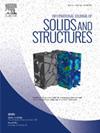Large deformation contact mechanics with Non-Slip Interfaces
IF 3.4
3区 工程技术
Q1 MECHANICS
International Journal of Solids and Structures
Pub Date : 2025-05-23
DOI:10.1016/j.ijsolstr.2025.113474
引用次数: 0
Abstract
When a rigid paraboloid is deeply pressed into an elastomer with high surface energy, the interfacial tangential force becomes a significant factor that must be considered. To derive clear and accessible analytical solutions, we developed a modified theory for large deformation non-slip contact between a rigid paraboloid and a half-space elastomer, based on the principles of hyperelasticity. Our non-slip theory hinges on the large deformation coefficient θ. The non-slip theory expression can be succinctly described as the Hertz solution multiplied by θ. This coefficient is a critical indicator to evaluate the applicability of the small deformation assumption. If θ surpasses the allowable tolerance, the small deformation model is no longer valid. Our non-slip theory predicts higher external forces compared to the Hertz model, with predictions aligning more closely with finite element analyses and experimental data, particularly for materials with low Poisson’s ratio values. We also extend our non-slip theory to explain adhesion, enabling the large deformation modification of the JKR theory. This extension reveals that the adhesion forces are negligible compared to the pressures associated with large deformations. Our non-slip theory thus demonstrates its robust adaptability for applications involving adhesion. This research provides a pivotal theoretical framework that enhances our understanding of contact mechanics, particularly relevant to the large deformation contact issues between punches and elastomers.
具有防滑界面的大变形接触力学
当刚性抛物面被深压成具有高表面能的弹性体时,界面切向力成为必须考虑的重要因素。为了得到清晰易懂的解析解,我们基于超弹性原理,开发了一种修正理论,用于刚性抛物面和半空间弹性体之间的大变形防滑接触。我们的防滑理论依赖于大的变形系数θ。防滑理论表达式可以简洁地描述为赫兹解乘以θ。该系数是评价小变形假设适用性的重要指标。如果θ超过允许公差,则小变形模型不再有效。与赫兹模型相比,我们的防滑理论预测了更高的外力,预测与有限元分析和实验数据更接近,特别是对于具有低泊松比值的材料。我们还扩展了我们的防滑理论来解释粘附,使JKR理论的大变形修正成为可能。这种扩展表明,与大变形相关的压力相比,附着力是可以忽略不计的。因此,我们的防滑理论证明了它对涉及粘附的应用的强大适应性。这项研究提供了一个关键的理论框架,增强了我们对接触力学的理解,特别是与冲头和弹性体之间的大变形接触问题有关。
本文章由计算机程序翻译,如有差异,请以英文原文为准。
求助全文
约1分钟内获得全文
求助全文
来源期刊
CiteScore
6.70
自引率
8.30%
发文量
405
审稿时长
70 days
期刊介绍:
The International Journal of Solids and Structures has as its objective the publication and dissemination of original research in Mechanics of Solids and Structures as a field of Applied Science and Engineering. It fosters thus the exchange of ideas among workers in different parts of the world and also among workers who emphasize different aspects of the foundations and applications of the field.
Standing as it does at the cross-roads of Materials Science, Life Sciences, Mathematics, Physics and Engineering Design, the Mechanics of Solids and Structures is experiencing considerable growth as a result of recent technological advances. The Journal, by providing an international medium of communication, is encouraging this growth and is encompassing all aspects of the field from the more classical problems of structural analysis to mechanics of solids continually interacting with other media and including fracture, flow, wave propagation, heat transfer, thermal effects in solids, optimum design methods, model analysis, structural topology and numerical techniques. Interest extends to both inorganic and organic solids and structures.

 求助内容:
求助内容: 应助结果提醒方式:
应助结果提醒方式:


